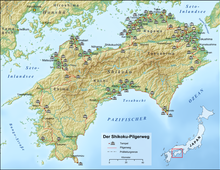Japanese Pilgrimage Oliver Statler
| ||
| ||
| Japanese Pilgrimage. Oliver STATLER. This is the grandfather of all English language books written about the pilgrimage. He spent about three months walking the pilgrimage in 1971 and this is a thoughtful and insightful accounting of that trip and another partial trip in 1968, with enough history (although partly fictionalized) to help us understand the big picture. An absolute 100% must read for anyone contemplating walking the pilgrimage. Pan Books, 1984 ----- |
From Wikipedia, the free encyclopedia
Jump to navigationJump to search
Map all coordinates using: OpenStreetMap
Download coordinates as: KML· GPX
![]()
Map of the 88 temples along the Shikoku Pilgrimage
![]()
Pilgrims at Zentsū-ji, Temple 75 and the birthplace of Kūkai
![]()
An aruki-henro or walking pilgrim, marked out by his distinctive sedge hat, white shirt, and kongō-zue. The henro-michi route passes through the countryside and a number of cities.
![]()
The Shikoku Pilgrimage (四国遍路 Shikoku Henro) or Shikoku Junrei (四国巡礼) is a multi-site pilgrimage of 88 templesassociated with the Buddhist monkKūkai (Kōbō Daishi) on the island of Shikoku, Japan. A popular and distinctive feature of the island's cultural landscape, and with a long history, large numbers of pilgrims, known as henro (遍路), still undertake the journey for a variety of ascetic, pious, and tourism-related purposes.[1] The pilgrimage is traditionally completed on foot, but modern pilgrims use cars, taxis, buses, bicycles, or motorcycles. The standard walking course is approximately 1,200 kilometres (750 mi) long and can take anywhere from 30 to 60 days to complete.
In addition to the 88 "official" temples of the pilgrimage, there are over 20 bangai — temples not considered part of the official 88. To complete the pilgrimage, it is not necessary to visit the temples in order; in some cases it is even considered lucky[citation needed] to travel in reverse order. Henro(遍路) is the Japanese word for pilgrim,[2] and the inhabitants of Shikoku call the pilgrims o-henro-san (お遍路さん), the o (お) being an honorificand the san (さん) a title similar to "Mr." or "Mrs.". They are often recognizable by their white clothing, sedge hats, and kongō-zue or walking sticks. Alms or osettai are frequently given. Many pilgrims begin and complete the journey by visiting Mount Kōya in Wakayama Prefecture, which was settled by Kūkai and remains the headquarters of Shingon Buddhism. The 21 kilometres (13 mi) walking trail up to Koya-san still exists, but most pilgrims use the train.
Contents
1History
1.1Background
1.2Kōbō Daishi
1.3Development
2Practice
2.1Stages
2.2Equipment
2.3Rites
3Imitative versions
4Temples
5See also
6References
7Further reading
8External links
Japanese Pilgrimage [Hardcover]
Oliver Statler (Author)
Jump to navigationJump to search
Map all coordinates using: OpenStreetMap
Download coordinates as: KML· GPX

Map of the 88 temples along the Shikoku Pilgrimage

Pilgrims at Zentsū-ji, Temple 75 and the birthplace of Kūkai

An aruki-henro or walking pilgrim, marked out by his distinctive sedge hat, white shirt, and kongō-zue. The henro-michi route passes through the countryside and a number of cities.

The Shikoku Pilgrimage (四国遍路 Shikoku Henro) or Shikoku Junrei (四国巡礼) is a multi-site pilgrimage of 88 templesassociated with the Buddhist monkKūkai (Kōbō Daishi) on the island of Shikoku, Japan. A popular and distinctive feature of the island's cultural landscape, and with a long history, large numbers of pilgrims, known as henro (遍路), still undertake the journey for a variety of ascetic, pious, and tourism-related purposes.[1] The pilgrimage is traditionally completed on foot, but modern pilgrims use cars, taxis, buses, bicycles, or motorcycles. The standard walking course is approximately 1,200 kilometres (750 mi) long and can take anywhere from 30 to 60 days to complete.
In addition to the 88 "official" temples of the pilgrimage, there are over 20 bangai — temples not considered part of the official 88. To complete the pilgrimage, it is not necessary to visit the temples in order; in some cases it is even considered lucky[citation needed] to travel in reverse order. Henro(遍路) is the Japanese word for pilgrim,[2] and the inhabitants of Shikoku call the pilgrims o-henro-san (お遍路さん), the o (お) being an honorificand the san (さん) a title similar to "Mr." or "Mrs.". They are often recognizable by their white clothing, sedge hats, and kongō-zue or walking sticks. Alms or osettai are frequently given. Many pilgrims begin and complete the journey by visiting Mount Kōya in Wakayama Prefecture, which was settled by Kūkai and remains the headquarters of Shingon Buddhism. The 21 kilometres (13 mi) walking trail up to Koya-san still exists, but most pilgrims use the train.
Contents
1History
1.1Background
1.2Kōbō Daishi
1.3Development
2Practice
2.1Stages
2.2Equipment
2.3Rites
3Imitative versions
4Temples
5See also
6References
7Further reading
8External links
Japanese Pilgrimage [Hardcover]
Oliver Statler (Author)
